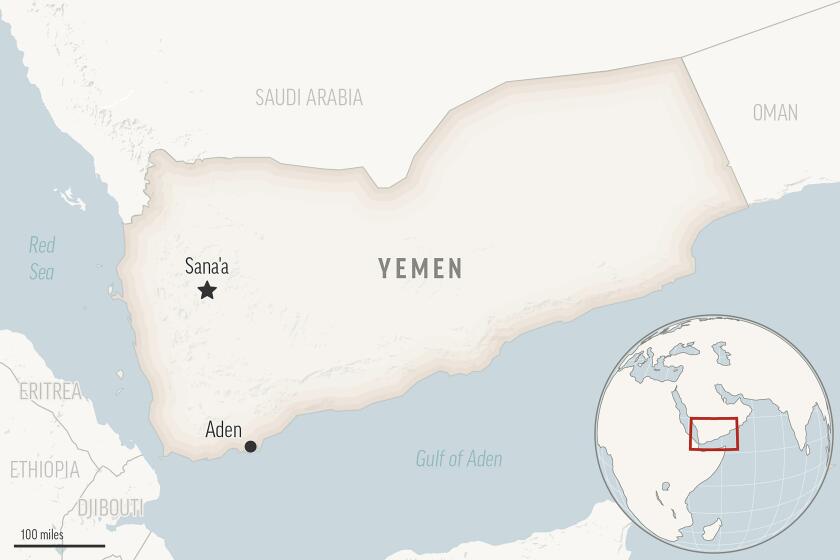Wants to Be Financial Hub of Western Pacific : Guam Polishes Image: ‘New Hong Kong’
- Share via
AGANA, Guam — Guam’s leaders are working to transform their “anchored battleship” of an island into a “new Hong Kong.” The image may not yet click, they say, but give it time.
“When you think of Guam now,” says Dave J. Santos, tax chief and image-seller for the Guam government, “you think of a big military rock, of 300 B-52s bombing the hell out of Vietnam.”
But he and others want international businessmen eventually to think of this U.S. territory and military hub as a western Pacific financial center--as strategically located for them as it is for the admirals.
They have already scored one coup: attracting many of America’s biggest corporations to establish tax-shelter subsidiaries in Guam in recent months.
Their next goal is to win new tax-writing flexibility from the U.S. government, in order to build the low-tax system they believe is needed to get into the banking-and-services big time in the booming Far East.
Palmy, Tropical
Palmy, tropical, 30-mile-long “Guam USA” is tuned in to two worlds--one thoroughly American, the other Oriental.
Along bustling Route 1, Guamanians stream into a giant McDonald’s (328 seats) for morning Egg McMuffins, shop in a five-story Ben Franklin store, cash checks at the Bank of America low-rise, and pack Agana’s downtown stadium for nightly semiprofessional baseball.
Merrill, Lynch stockbroker Joe Stoll, the local Chamber of Commerce chairman, keeps his dual-time-zone watch set to Wall Street, 15 hours behind Guam.
“People forget just how far away we are. They think we’re somewhere next door to Hawaii,” Stoll, a Milwaukee native, said with a laugh.
Actually Guam lies farther west from Hawaii, 4,000 miles, than Hawaii is from the U.S. mainland.
It is Japan, a three-hour flight north of here, that is practically next door. About 300,000 Japanese vacationers a year flock to resorts on Tumon Bay’s sweeping curve of a beach, where hotel televisions offer the Tokyo nightly news and Japanese soap operas; sushi bars abound.
Military Economic Bedrock
But the military remains the economic bedrock of Guam, a U.S. possession since 1898.
An Air Force bomber base, a Navy harbor and nine other Defense Department facilities cover one-third of Guam’s 215 square miles. Military personnel and dependents account for one-fifth of the island population of 116,000. And servicing the military through supply, retail and other businesses is Guam’s chief economic activity.
“We’re . . . just an anchored battleship out here in the Pacific,” Gov. Ricardo J. Bordallo has said.
Between the military and government--the federal and territorial administrations employ half the civilian work force--the private sector has had little room to flourish. Bordallo’s Democratic administration, with an eye to reducing a chronic double-digit unemployment rate, is trying to change that.
Last year, the Guamanians seized on a new provision of U.S. tax law to get corporate America interested in the island.
The legislation allowed U.S. exporters to establish foreign sales corporations--called FSCs--in U.S. territories, subsidiaries through which they could book overseas sales and defer U.S. taxes on them. Such tax-shelter companies had been incorporated in the domestic United States, but other countries objected to that as an improper subsidy of exports.
Signed Up Corporations
Bordallo and Revenue Director Santos went on a barnstorming tour of 15 U.S. cities last fall to sign up corporations, and at least 187 have set up their FSCs in Guam thus far, among them such “Fortune 500” names as General Electric, United Technologies and Citicorp.
The FSCs will produce little direct employment here. They are only “paper” companies whose parents will continue to process sales at the home office.
“We’re really looking for a long-term benefit,” Santos, 33, said in an interview at his beachside Revenue Department office. “Once these guys see what Guam has--an excellent harbor and airport, the infrastructure--they’ll say, ‘This is not what I pictured,’ and maybe they’ll do more business out here.”
Guam officials say their island is centrally situated for major sales or manufacturing operations in east Asia, and offers the political and financial stability of the U.S. flag and dollar.
“Guam could be a good regional center for executives,” Stoll said. “For one thing, expenses--housing costs, food costs--are far lower here than in Tokyo or Hong Kong.”
Long-Range Plans Ambitious
The islanders’ long-range plans are more ambitious.
In a series of local hearings, they have debated proposals for establishing a comprehensively legislated “commonwealth” relationship with the United States, a status like Puerto Rico’s.
More to Read
Sign up for Essential California
The most important California stories and recommendations in your inbox every morning.
You may occasionally receive promotional content from the Los Angeles Times.













